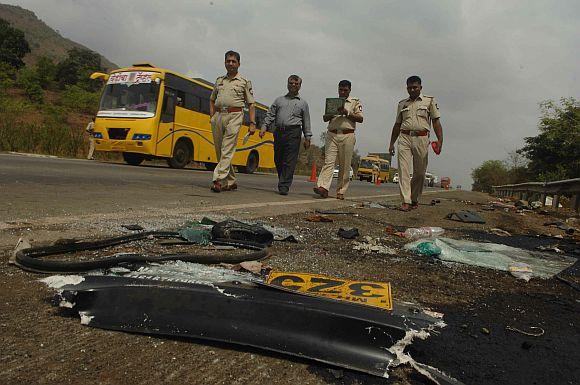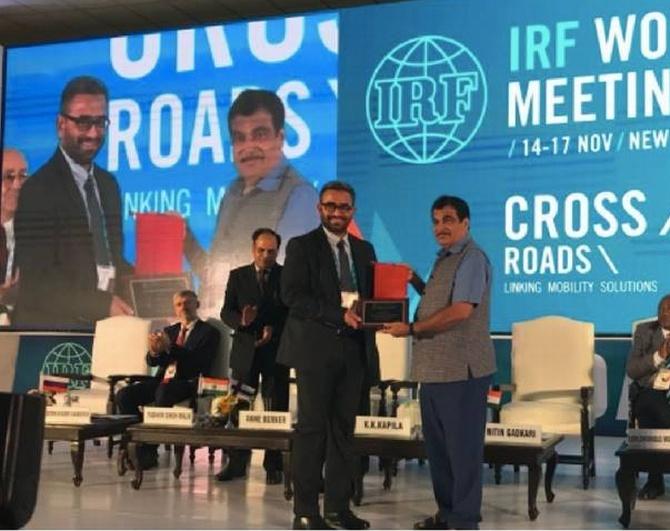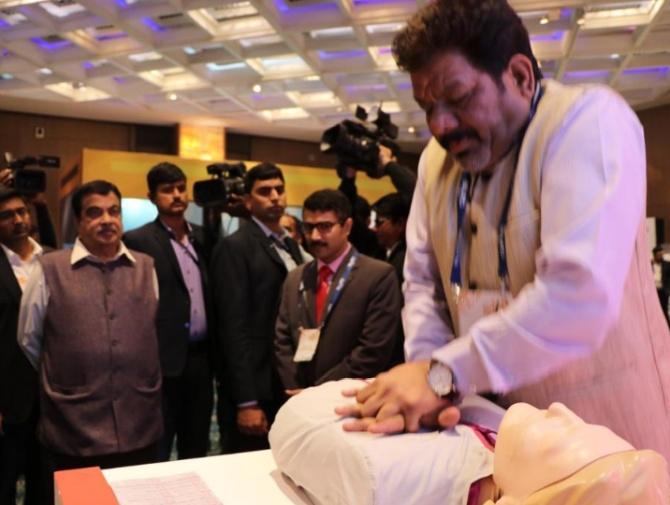Indian roads continue to be among the most dangerous in the world.
Few people are even aware that the Good Samaritan Law exists.
Getting a licence to drive is still far too easy.
Veenu Sandhu reports.

'By December 2021, we intend to make the Mumbai-Pune Expressway a zero-fatality corridor -- India's first,' says Piyush Tewari CEO, SaveLIFE Foundation.Photograph: Saahil Salvi
On the afternoon of April 5, 2007, a 15-year-old boy was returning from school. As he crossed the road, a vehicle coming from the opposite direction hit him.
He fell to the ground, and the driver, reversing the vehicle in an attempt to flee, ran him over again. For the next 45 minutes, the boy, who was in school uniform, lay on the road.
"A large number of people, I understand, stopped to see what was going on but not one did anything that could save his life. Nobody took him to hospital or called the police or gave him first aid. He bled to death in full public view," says Piyush Tewari.
The incident happened in Kanpur. The boy was Tewari's cousin, his junior by 12 years.
"He was in our care. His father, my maternal uncle, had died in a road crash when he was six months old," says Tewari, who was heading the India operations for a US-based private equity firm at the time.
Tewari took a break from work and travelled across the country to understand why people do not make even a basic attempt to save a life.
He met with lawyers, doctors, police officers, other victims' families and established three facts: his cousin's case was not isolated (nearly 50 per cent of road accident victims die despite having treatable injuries); in the previous decade, close to a million people were killed in road crashes in India, yet there was barely any conversation around the subject; and public inaction was not driven by apathy but by a profound fear of harassment.

Nine months later, on February 29, 2008, Tewari set up the SaveLIFE Foundation. The Delhi-based organisation, which is working to make roads safer and improve accident emergency care, is behind the 'Good Samaritan Law' instituted by the Supreme Court of India on March 30, 2016.
The law, which is binding on all states and Union territories, provides legal protection to bystanders who come to the aid of road crash victims.
Before this, in 2014, based on SLF's public interest litigation, the Union government had struck down a provision in the Central Motor Vehicles Rules that allowed for protruding rods, mandating that these be carried only in covered trailers, and fixing criminal liability on violators.
"Initially I didn't quit my job because road safety attracted hardly any funding," says Tewari, whose salary and family resources sustained the operations for the first three years.
He knew when they started that they needed to engage with the police -- people were primarily afraid of police harassment.
"We thought of doing a bit of social engineering -- by making the police life-savers and training them to become medical first responders to road crash victims."
The All India Institute of Medical Sciences trauma centre in Delhi came on board to partner with SLF to train police officers in basic trauma care skills.
Soon, reports of the police using those skills on critically injured victims started coming in. More than 15,000 policemen across 10 states have since been trained.
One particular case, of a motorcyclist who had been run over by a truck in front of the Siri Fort auditorium in Delhi on the night of June 4, 2009, really got things moving for SLF.
While taking him to the AIIMS trauma centre, the police team was able to revive him by performing CRP (cardiopulmonary resuscitation) and bleeding control on him in the vehicle. "I remember getting a fax from the office of the deputy commissioner of police about it," recalls Tewari.
Thereon, he began to be invited to participate in government conversations around road safety and trauma care.

"I started using that opportunity to ask for bigger things. My number one demand was for a law that would protect Good Samaritans."
But apart from a polite acknowledgment of his demand, nothing moved. And in 2012, Tewari, who had by then quit his job, filed a PIL in the Supreme Court.
While fighting the case, he started discovering more reasons behind road crashes. Driver behaviour was only one of them. Existing systems of handing out licences and driver training were compromised.
Driving schools with no accreditation or registration gave training in how to operate a vehicle but virtually ignored road safety. There were also enforcement and road engineering challenges. Nobody talked about child safety.
There was only a Supreme Court guideline regarding displaying the principal's phone number on a school bus. But only a fraction of students uses school buses; most use public transport, or walk or cycle to school.
SLF started advocating for a comprehensive road safety law for India. The death of Union minister Gopinath Munde in a road crash in Delhi in June 2014 was what finally triggered a serious, actionable, conversation at the central government level about the need for such a law.
Tewari and his team of lawyers, policy researchers, engineers and urban designers got involved in the drafting process and on September 1 last year, the Union government notified the Motor Vehicles (Amendment) Act, 2019.
While enhanced penalties for driving errors have been its most publicised point, the Act has brought in several other critical structural reforms.
It has introduced child safety norms (mandatory seat belts and helmets for children above a certain age) and reforms in the licensing process; for the first time made engineers and road-building contractors accountable for shoddy road construction; prescribed electronic enforcement to do away with corruption, and so on.
States have been given the power to decide penalties in 24 sections, with the Union government prescribing the upper limit.
In 2016, SLF also decided to pick up one of India's deadliest roads and make it safer. It chose the Mumbai-Pune Expressway, which had become notorious for road accidents.
Over the next three years, through forensic crash investigation into engineering gaps, and human and vehicular errors, it identified 15 types of engineering errors that were repeated 2,150 times over the 95-km stretch.
For instance, there were exposed concrete structures along the road into which a vehicle, if it veered off, could smash.
There were gaps in the median and visibility challenges because of overgrown bushes at sharp turns.
To date, about 1,450 of these errors have been fixed.
The trauma response has also been brought down from 45 minutes to seven to eight minutes, not by adding new ambulances but by strategically placing existing ones near vulnerable stretches.
An intelligent traffic management system with 50 cameras to capture violations is now being put in place.
As of September 2019, the number of deaths on the stretch is down by 54 per cent from 2016.
"By December 2021, we intend to make it a zero-fatality corridor -- India's first," says Tewari, adding that none of this would have been possible without active government engagement.
"MSRDC (the Maharashtra State Road Development Corporation) has in the last three years spent Rs 150 crore in fixing the errors we told them about," he says.
SLF has now signed a memorandum of understanding with the Delhi government and adopted a 10 km stretch of the busy Outer Ring Road (from the Signature Bridge to Bhalswa Chowk).
Since their work is focused on bringing about a change in the system, it cannot happen without government support.
"So we cannot work everywhere," says Tewari.
Building a trauma registry is next on the agenda. Currently, data on accident deaths is compiled through first information reports recorded immediately after an accident.
If the victim dies some days later, the death is entered in the chargesheet and not the FIR. A lot of deaths by accidents remain unrecorded because of this.
The trauma registry will shift the data collection from the police to the health care system and carry details of injuries.
"For effective interventions, we need information that is a lot more granular," says Tewari.
The SLF CEO is pushing for a "safe system approach", which works on the premise that human beings are fallible, but the system should be such that it does not punish their mistake with injury or death.
Indian roads, meanwhile, continue to be among the most dangerous in the world.
Few people are even aware that the Good Samaritan Law exists. Getting a licence to drive is still far too easy.
Tewari and his team at SLF are staring at a long, onerous journey, but they are determined to keep their eyes on this road.











